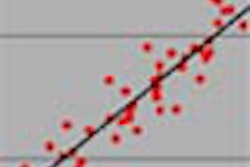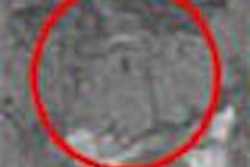Poor colonic distension is one of virtual colonoscopy's big deal-breakers -- factors such as incomplete colonic cleansing or retained fluid that can lower the exam's sensitivity to unacceptable levels. Insufflation is important because polyps cannot generally be detected in collapsed colon segments. So as distension worsens, so does the accuracy of the virtual exam.
In an effort to make this process more reliable, and perhaps even faster, an electronic technique has been developed to replace manual squeeze-bulb air insufflation with automated administration of carbon dioxide CO2, which can be more comfortable for the patient than room air.
In one of the first controlled tests of the technology, researchers from the University of California, San Francisco, found that electronically administered CO2 offers significantly better colonic distension than manually administered room air, especially when the patient is supine.
"The purpose of our study was to compare colonic distension in patients receiving electronic carbon dioxide versus manual room air insufflation for CT colonography," said lead investigator Dr. Judy Yee at the 2002 RSNA meeting in Chicago.
Her team also sought to determine whether the results of an automated distension-measuring technique were consistent with the radiologist's visual assessment. So in addition to a single radiologist's reading of axial images and sagittal multiplanar reconstructions (grading distension in each segment on a scale of 1 to 5), an automated colon distension measuring technique was employed as a second read for measuring distension.
The distension-measuring algorithm was developed at Stanford University in Stanford, CA, Yee said (Radiology, February 2002, Vol. 222:2, pp. 543-554).
Yee and colleagues Dr. Gregory Galdino, Dr. Naveen Kumar, and Dr. Albert Nico, administered room air manually to tolerance in 58 patients, after colonic cleansing and prior to image acquisition. Approximately half of the subjects underwent virtual colonoscopy on a single-detector row scanner, and half had the exam on a four-slice multidetector-row spiral CT scanner.
Electronic CO2 insufflation was performed on a Protocol colon insufflator (E-Z-EM, Westbury, NY), and flow settings were adjusted from 2-3 liters per minute to patient tolerance, to a maximum of 25 mm Hg. Adjustments were also made if there was evidence of collapsed segments on the CT scout image.
Manual air insufflation was performed to tolerance in 60 subjects, using 30-50 puffs of room air, with 10-20 additional puffs given if there was evidence of segment collapse on the scout image, Yee said. Mean volume was 6.3 liters, ranging from 3-13.6 liters, with the higher numbers resulting from CO2 being expelled in a few cases.
The patients then underwent CT imaging of the colon. Single-detector CT was performed in half of the patients using 3-mm collimation, 120 kVp, 120-150 mAs and pitch of 1.5 to 2.0, with 1.5-mm overlapping reconstruction.
Multidetector row CT was performed in the remaining patients, using 4 x 2.5 mm collimation, pitch of 1.5 to 2.0, kVp and mAs of 120, with 1.35-mm overlapping reconstruction. The colon was divided into six segments, including the rectum (R), sigmoid colon (SC) descending colon (DC), transverse colon (TC), ascending colon (AC), and cecum (C), Yee said.
A single radiologist read axial images and sagittal multiplanar reconstructions to manually grade distension in each colon segment on a scale of 1 to 5, with 5 meaning the segment was maximally distended. The automated distension-measuring technique was also applied to all 236 supine and prone datasets. The SDCT and MDCT results were merged together because there was no significant difference in the results, as measured by both the manual and automated measurement systems, according to Yee.
In all, the group evaluated 1,416 colon segments. Automated CO2 insufflation method produced better results in supine position for all segments.
"Comparing air and CO2 using the qualitative rating scores, if we focus on the (results) where p < 0.5 ... there was consistently significant better distension using CO2 in the supine position for all segments," Yee said.
CO2 was not superior in the prone position because "most segments were (already) well distended on prone with air, with the exception of the transverse colon," she said. In that segment, distension was better in the supine position regardless of whether air or CO2 was used.
"So in conclusion, electronic CO2 (insufflation) provided good colonic distension for all segments in the supine position, with excellent correlation between the qualitative and quantitative analysis," Yee said.
The group did not evaluate manual versus electronic CO2 insufflation because they were unable to manually administer the CO2 fast enough to achieve adequate distension.
By Eric BarnesAuntMinnie.com staff writer
March 12. 2003
Related Reading
Waist size predicts optimal CT dose in virtual colonoscopy, February 7, 2003
Perforation rate during colonoscopy similar to that of sigmoidoscopy, February 6, 2003
German group optimizes barium-sulfate tagging in MR colonography, January 22, 2003
Workflow issues key in virtual colonoscopy, January 15, 2003
E-Z-EM posts positive Q2, January 15, 2003
Copyright © 2003 AuntMinnie.com



















